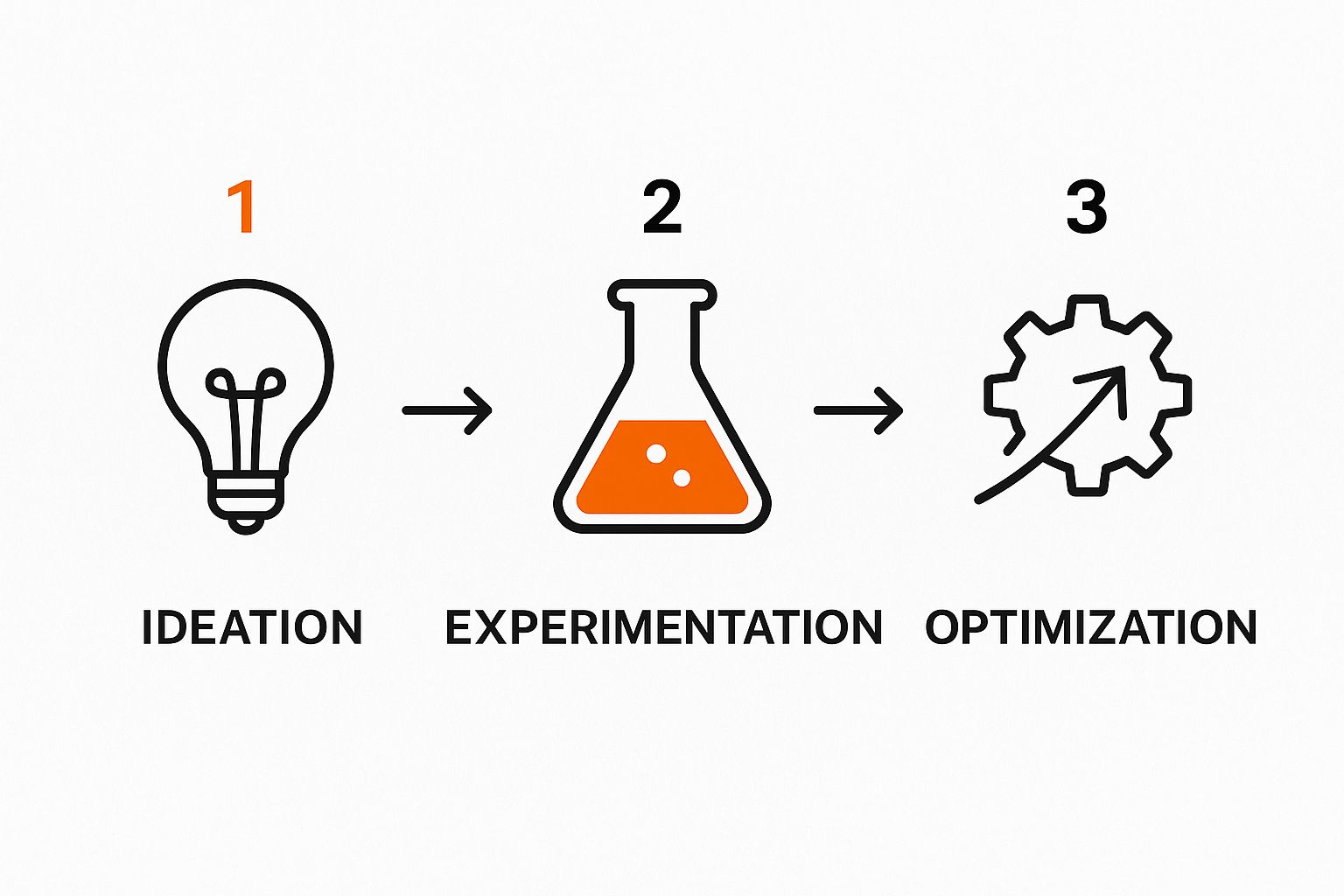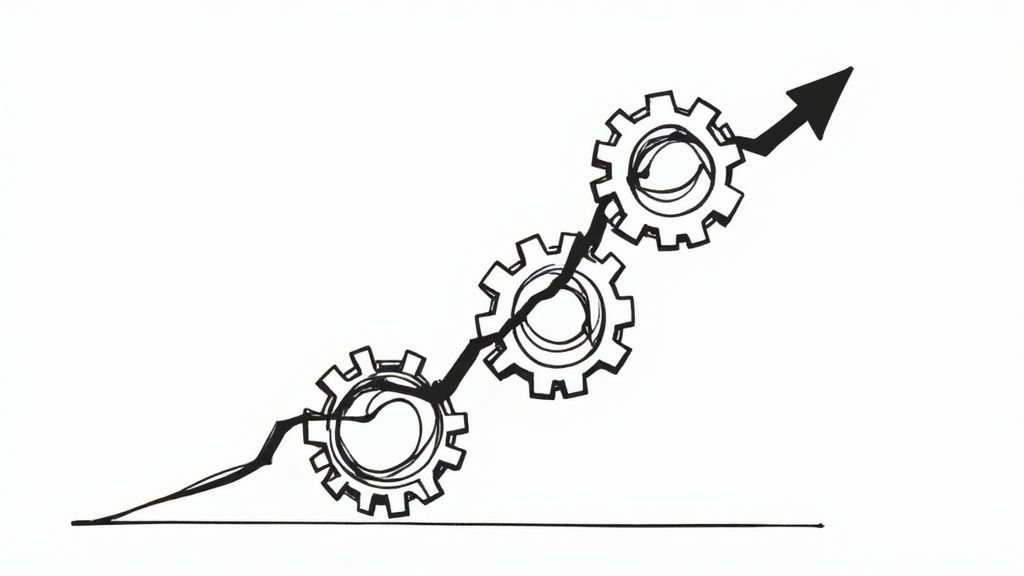What Is Growth Hacking Your Guide to Rapid Growth

Forget everything you think you know about marketing for a moment. Growth hacking isn't about big budgets or flashy Super Bowl ads. It's a different beast entirely. At its core, it’s a data-driven mindset laser-focused on rapid experimentation to find scalable ways to grow a business.
It’s less of a single trick and more of a relentless, scientific process. Think of it as a continuous loop of testing ideas across marketing, product development, and even engineering to uncover the most efficient paths to growth.
So, What Is Growth Hacking Anyway?

Imagine a scientist in a lab, but instead of beakers and chemicals, their tools are A/B tests, analytics dashboards, and user feedback. A traditional marketer might plan a massive campaign hoping for brand awareness. A growth hacker, on the other hand, formulates a hypothesis—"What if we change the sign-up button from blue to green?"—and then runs a small, controlled experiment to see what happens.
This agile approach is what really sets it apart. While traditional marketing often focuses on the top of the funnel (awareness and acquisition), a growth hacker obsesses over the entire customer journey. They're digging into every single step, from how someone first discovers the product all the way to the moment they become a raving fan and refer a friend. Every decision is guided by data, not gut feelings.
A Mindset Born From Need
The term "growth hacking" was officially coined back in 2010 by Sean Ellis. He was working with early-stage startups and realized they needed a completely new kind of marketer. These companies didn't have the luxury of massive budgets; they needed someone whose north star was purely scalable growth. This person had to be a unique blend of marketer, data analyst, and product developer.
That’s why this experimental nature is so powerful. By constantly testing and iterating, growth hackers can quickly pinpoint what works and double down on it, while just as quickly ditching what doesn't. For any business trying to make a big splash with limited resources, this is a total game-changer. It’s all about finding clever, repeatable ways to grow—a philosophy that’s absolutely essential when you're learning how to grow your business online.
Growth hacking is not about a single tactic; it's a disciplined, scientific process of discovering how to build a self-perpetuating growth machine. It prioritizes scalable results over traditional marketing metrics.
When you boil it down, this entire approach really centers on three core activities:
- Analyzing Data: Getting deep into user behavior to spot hidden opportunities and friction points.
- Running Experiments: Continuously testing new ideas to acquire, activate, and retain users.
- Optimizing the Product: Building growth mechanisms right into the product itself, making the user experience the marketing engine.
Growth Hacking vs. Traditional Marketing at a Glance
To make the distinction crystal clear, let's break down how these two approaches stack up side-by-side. While they can and often do work together, their core philosophies are fundamentally different.
| Aspect | Growth Hacking | Traditional Marketing |
|---|---|---|
| Primary Goal | Scalable, rapid growth at any stage of the funnel | Brand awareness, lead generation, and sales |
| Process | Agile, iterative, and experimental (hypothesize, test, analyze, repeat) | Campaign-based, planned well in advance |
| Focus | The entire user journey (from awareness to referral) | Primarily the top of the funnel (attracting customers) |
| Budget | Low-cost, high-impact tactics; often lean or bootstrapped | Often requires significant upfront investment |
| Metrics | User acquisition cost, lifetime value, conversion rates, viral coefficient | Reach, impressions, brand recall, market share |
| Team Skills | T-shaped: blends marketing, data analysis, and product development | Specialized roles (e.g., SEO specialist, brand manager) |
This table really highlights the shift in mindset. Growth hacking is less about "doing marketing" and more about building a system where growth is an inherent part of the product and business operations.
The Mindset Behind Exponential Growth

To really get what growth hacking is all about, you have to let go of a lot of traditional marketing ideas. It’s not a rigid playbook. It’s a mindset—a relentless, agile way of thinking built on a few core beliefs that swap big budgets and lengthy planning for speed, data, and a dash of creative genius.
The first and most important pillar is data-driven decision-making. A true growth hacker lives and breathes data. Gut feelings and assumptions are out; hard metrics are in. Every single idea is just a hypothesis waiting to be tested, and every result, good or bad, is a piece of intel for the next move.
This obsession with data fuels the second pillar: creative, low-cost experimentation. Growth hackers are always in the lab, running small, rapid-fire tests across every channel and product feature imaginable. Instead of betting the farm on one massive campaign, they’ll test dozens of different headlines, sign-up flows, or email subject lines to see what actually makes a difference.
Focusing on the Entire Customer Journey
Where old-school marketing often fixates on just getting new customers in the door, growth hacking looks at the whole picture. The entire customer lifecycle is fair game. This is where the famous "Pirate Metrics" or AARRR funnel comes in, breaking the journey into five distinct, measurable stages.
- Acquisition: How do people even find you? This is all about nailing down the most effective channels, whether it's organic search, viral loops, or something no one's thought of yet.
- Activation: Was their first experience a good one? This stage is about getting new sign-ups to that "aha!" moment as fast as humanly possible.
- Retention: Do they stick around? Growth hackers are obsessed with plugging leaks in the bucket, fighting churn, and keeping users engaged for the long haul.
- Referral: Do they love you enough to tell their friends? This is where you build mechanics that turn happy users into your best salespeople.
- Revenue: How do you actually get paid? This final stage is about converting users to paying customers and maximizing their value over time.
By tweaking and optimizing each step of this funnel, you create a powerful system where one improvement feeds the next. For instance, better retention naturally creates more chances for referrals and, ultimately, more revenue.
The goal isn't just to pour more users into the top of the funnel; it's to fix the leaks and widen the path at every single step, turning a trickle of users into a flood of loyal customers.
Building Growth into the Product
Finally, a huge part of the growth hacking mindset is realizing that your product is your single best marketing tool. This is the heart of Product-Led Growth (PLG), a strategy where features are intentionally designed to drive acquisition and keep users coming back.
Just think about Dropbox’s referral program. They offered extra storage for free when you invited friends. That wasn't some ad campaign they ran on the side; it was baked right into the product experience. This simple feature turned their entire user base into a massive, highly effective, and ridiculously cheap sales force. It’s the perfect example of the core principle: the best marketing often doesn't feel like marketing at all.
A Repeatable Framework for Finding Growth
Growth hacking isn't about pulling a single, magical idea out of a hat. It's really a disciplined, repeatable process that turns creative sparks into measurable results. Think of it as a cycle—a structured way to consistently discover what works, scale it, and move beyond guesswork into a system of predictable growth.
This is what truly separates growth hacking from traditional marketing, which often bets big on large, pre-planned campaigns. Instead, growth hackers live in a world of rapid-fire hypotheses, quick tests, and constant optimization. We use data to watch metrics like conversion rates and user activation, allowing us to find scalable growth drivers where other methods might fall short.
The Three Core Stages of Growth
The whole process boils down to a simple, powerful loop that any team can adopt to start making real progress.

This visual nails the three core steps: cooking up ideas (Ideation), testing them in the wild (Experimentation), and then using what you learn to get better (Optimization). It’s a straightforward flow that ensures every action is purposeful and builds on what came before.
1. Generate and Prioritize Ideas
Everything starts with brainstorming. Your team needs to build a backlog of potential growth ideas, no matter how small or off-the-wall they seem. A huge part of this is figuring out how to create viral content that gets people talking.
Once you have a list, you have to prioritize. A favorite method in the growth world is the ICE framework, which scores each idea based on three criteria:
- Impact: If this works, how big of a deal will it be?
- Confidence: How sure are we that this will actually work?
- Ease: How much time and effort will this take to build?
This simple scoring system helps you zero in on the high-impact, low-effort experiments first. Of course, none of this works without a deep understanding of who you're building for. To sharpen your ideas, you absolutely have to start with a solid https://www.lumeo.me/en/blog/target-audience-analysis.
2. Design and Launch Experiments
With a prioritized idea in hand, the next step is to design a small, controlled experiment. Speed is everything here. Instead of building a full-blown feature, you might throw up a simple landing page to test a value proposition or run a tiny ad campaign to see if an offer has legs. The goal is to get real-world data as fast as possible with the least amount of investment.
A growth experiment is not a guess; it is a question you ask your users. The data you get back is their answer.
3. Analyze and Iterate
After the experiment runs its course, you dig into the results. Did it work? Why or why not? The findings—good or bad—are pure gold.
A successful test gives you the green light to scale up and bake it into your core strategy. A failed test is just as valuable; it teaches you what your audience doesn't want, helping you dodge bigger mistakes down the road. This new knowledge then feeds right back into the ideation stage, kicking off the cycle all over again with smarter, more informed ideas.
Learning from Iconic Growth Hacking Stories

Theory is one thing, but seeing growth hacking in action is where it all clicks. The most legendary growth stories weren't fueled by nine-figure ad budgets. They came from clever, almost deceptively simple strategies that wove marketing right into the fabric of the product.
These aren't just fun startup tales to tell over coffee. They're practical blueprints that show how the core principles of growth hacking can blow the doors off your projections. Let's pull them apart and see what really made them work.
Dropbox Incentivized Sharing
Back in the day, Dropbox was entering a crowded market and needed a cheap way to get noticed. Instead of blowing their cash on ads, they built a brilliant referral program right into the product experience. It was genius in its simplicity.
The deal was a classic two-way street: invite a friend to join, and both of you get extra storage space for free. This single move turned their entire user base into a volunteer army of marketers. It was a masterclass in Product-Led Growth.
- Acquisition: New users came in through trusted recommendations from friends—one of the most powerful channels out there.
- Activation: The promise of free space was a huge motivator, getting people to sign up and start using the service immediately.
- Referral: The program created a viral loop that just kept going. Every new user was another potential salesperson.
This one feature drove a 60% increase in sign-ups, helping Dropbox rocket from 100,000 to 4 million users in a mere 15 months.
Airbnb Tapped into an Existing Audience
When Airbnb was just a fledgling idea, their biggest hurdle was the classic chicken-and-egg problem: how do you get properties without travelers, and how do you get travelers without properties? They realized the audience they needed was already gathered in one place: Craigslist. So, they got creative.
They built a simple tool that let hosts cross-post their Airbnb listings to Craigslist with a single click. Boom. Suddenly, Airbnb properties were popping up in front of millions of people who were actively searching for exactly what they offered.
This wasn't some official partnership. It was a scrappy, ingenious hack that piggybacked on a competitor's massive audience to kickstart their own. It’s the perfect example of the "work smarter, not harder" ethos.
By going where their target audience already was, Airbnb completely bypassed the slow, painful, and expensive process of building a marketplace from zero.
Hotmail Created a Viral Loop
The Hotmail story is one of the OGs of growth hacking. Long before it was bought by Microsoft, it was just another free email service trying to get the word out. Their solution was so simple it’s now legendary.
At the bottom of every single email sent from a Hotmail account, they added one simple line of text: "P.S. Get your free email at Hotmail." And, of course, it linked directly to their sign-up page.
This tiny tweak turned every email into a free ad. Each user became an accidental—but incredibly effective—promoter for the service. This sparked an exponential viral loop that took Hotmail from a standing start to 12 million users in 18 months. For the mid-90s internet, those numbers were simply unheard of.
Building Your Growth Hacker Toolkit
A growth hacker is only as good as their tools. While the right mindset and a solid process are the foundation, it's the software that turns raw data into actionable insights and lets you scale experiments efficiently. But let's be honest, navigating the sea of available tools can be overwhelming. The best way to approach it is to think in categories based on what you need to do.
Your tech stack is basically your command center. It's what allows you to measure, test, and learn at high speed. You don't need dozens of expensive platforms right out of the gate. Instead, focus on a core set of tools that cover the essential stages of the growth hacking cycle, from understanding user behavior to running targeted experiments.
Key Tool Categories for Growth
To run a modern growth strategy, you need a few key capabilities. Each of these categories solves a specific piece of the growth puzzle, helping you make smarter, data-driven decisions instead of just guessing what might work.
Analytics Platforms: These are completely non-negotiable. Tools like Google Analytics, Mixpanel, or Amplitude are the bedrock of any growth strategy. They help you track what users are doing, pinpoint where they're dropping off in your funnel, and measure the real impact of your experiments. Without solid analytics, you’re flying blind.
A/B Testing Software: To run experiments that actually mean something, you need dedicated A/B testing tools. Platforms like Optimizely or VWO let you test variations of headlines, calls-to-action, or even entire user flows to see what converts best. This is where your hypotheses meet cold, hard data.
User Acquisition and Feedback Tools: This is a broad category covering everything from SEO tools like Ahrefs for organic growth to customer survey tools like SurveyMonkey or Hotjar for getting qualitative feedback. These tools help you understand both how users find you and what they really think once they arrive.
Building Your Strategy and Tactics
Your toolkit gives you the power to execute, but your strategy tells you where to aim. Once you have your tools in place, a well-defined content distribution strategy is what ensures your experiments actually reach the right people. Marrying powerful software with a smart plan for getting your message out is the key to gaining traction and gathering meaningful data.
A tool is just an instrument; it's the growth hacker's ability to ask the right questions and design clever experiments that creates real impact. The software simply makes it possible to get answers at scale.
Ultimately, the tools you use will change as your company grows and your needs evolve. A great way to quickly expand your arsenal of tactics is to see how others are doing it. Dive into these proven 10 clever growth hacks to see how creative ideas get implemented with the right technology. The key is to start with a solid foundation and add new tools as you run into specific challenges or spot new opportunities.
Avoiding Common Growth Hacking Pitfalls
It’s tempting to think of growth hacking as a box of magic tricks, but getting it right is as much about what you don't do as what you do. So many promising strategies crash and burn, not because the ideas were bad, but because they stumbled into easily avoidable traps.
https://www.youtube.com/embed/y7a3emSHAFM
The biggest mistake? Treating growth hacking like a silver bullet—that one amazing tactic that will skyrocket your business overnight.
That's just not how it works. Real growth hacking is a slow, steady grind of incremental improvements. Just throwing ideas at the wall to see what sticks is a surefire way to burn through your time and money. The real wins come from a disciplined, repeatable cycle: hypothesize, test, learn, and repeat. It’s a process, not a one-off viral gimmick.
Another classic pitfall is getting so caught up in short-term wins that you sacrifice the long-term health of your brand. Sure, a spammy email blast might get you a bump in sign-ups this week, but it could also alienate your audience for good. Sustainable growth is about creating genuine value, not just chasing a number on a spreadsheet.
Chasing Vanity Metrics
It's so easy to get seduced by vanity metrics. These are the numbers that look great in a board meeting—things like page views or social media followers—but don't actually move the needle for the business. A million views means nothing if not a single one of those people ever signs up, becomes an active user, or gives you money.
The heart of good growth hacking is measuring what actually matters. You have to focus on actionable metrics like conversion rates, customer lifetime value (LTV), and user retention. Those are the numbers that tell you if you're building a real, sustainable business.
The goal is to stop feeding your ego with impressive-sounding stats and start focusing on data that helps you make smarter decisions.
When you get this right, the results can be massive. We've seen it happen. One retail client, for example, managed to increase their monthly revenue by a staggering 450% after running a series of structured growth experiments. Their direct-to-consumer run-rate shot up by 2700%. In another case, a banking client saw a 3-4% lift in their overall conversion rates just by applying these principles. It's proof that a methodical approach pays off. Discover more about how experts scale growth hacking and get these kinds of results.
Alright, as we start to land the plane on this whole growth hacking thing, a few questions usually pop up. Let's run through some of the most common ones to clear up any lingering confusion and get you ready to take the next step.
So, what skills does a growth hacker actually need to have? While being tech-savvy definitely helps, it's not the full picture. The best growth hackers are often T-shaped—they have a broad understanding across a bunch of marketing channels, but they go deep on one or two key areas, like data analytics or conversion rate optimization.
More than any single skill, though, is an insatiable curiosity and a data-first mindset.
Can Growth Hacking Work for Any Business?
You bet. While it got its start in the fast-paced tech startup world, the core ideas can work for anyone. Any business hunting for scalable growth—from an e-commerce shop to a B2B service company—can benefit from this experimental approach. The trick is to adapt the mindset to your specific industry and who you're trying to reach.
Think about a local bakery. They could "hack" their growth by testing a simple referral program: bring a friend, and you both get a free coffee. Then, they'd measure its direct impact on repeat business and new customers. The fundamental idea is the same: run low-cost experiments to figure out what actually drives measurable growth.
The real power of growth hacking isn't locked away in digital products. It's a flexible framework for solving problems that can be applied to any business model willing to trade old-school marketing assumptions for data-driven experiments.
How Can I Start Learning Growth Hacking?
You don't need a fancy certificate to get going. The best way to learn is to simply start doing it.
- Start small: Pick one single metric you want to improve, like how many people sign up for your newsletter.
- Brainstorm ideas: Come up with a list of small, testable ideas that could move that number.
- Run an experiment: Launch a basic A/B test on your website's call-to-action button.
- Analyze and repeat: See what the results tell you, learn from it, and then fire up the next experiment.
Ready to turn your best content into visually engaging carousels that stop the scroll? Lumeo uses AI to help you create stunning presentations from articles, videos, and more, maximizing your online visibility. Start creating for free and see the difference at https://lumeo.me.